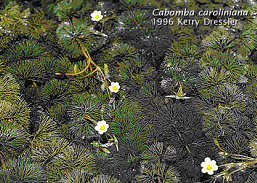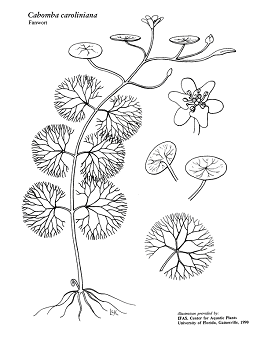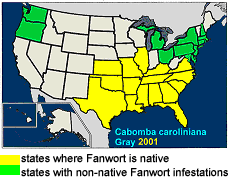Fanwort (Cabomba caroliniana)
Fanwort is a submerged invasive aquatic plant that can form dense mats at the water surface. The delicate green underwater leaves are fan- like and average 2 inches across. Leaves are arranged in opposite pairs on the stem. Small oval floating leaves are occasionally present. Small diamond-shaped floating leaves with the stem attached in the center may develop. Tubular stems can attain lengths of 6 feet
like and average 2 inches across. Leaves are arranged in opposite pairs on the stem. Small oval floating leaves are occasionally present. Small diamond-shaped floating leaves with the stem attached in the center may develop. Tubular stems can attain lengths of 6 feet
The white or cream flowers are ½" wide and form during May through September. Some variations of Fanwort have pinkish or purplish flowers.
Habitat
Fanwort is a very hardy and persistent species that has established itself in a wide range of aquatic habitats. Fanwort is native to  southern United States, but is non-native in northern regions. It over-winters in the frozen lakes of northern climates and can also thrive in warm southern water bodies. It grows under a wide range of water chemistry conditions and can be found in both oligotrophic (low-nutrient) and eutrophic (nutrient-rich) lakes. Fanwort can tolerate a wide range of temperature and pH. It prefers slow moving waters, including lakes and ponds, but occasionally can be found in rivers.
southern United States, but is non-native in northern regions. It over-winters in the frozen lakes of northern climates and can also thrive in warm southern water bodies. It grows under a wide range of water chemistry conditions and can be found in both oligotrophic (low-nutrient) and eutrophic (nutrient-rich) lakes. Fanwort can tolerate a wide range of temperature and pH. It prefers slow moving waters, including lakes and ponds, but occasionally can be found in rivers.
Distribution Map

Reproduction
Fanwort reproduces by both vegetative methods and by seeds. Vegetatively, C. caroliniana reproduces by stem (rhizome) fragmentation. Stems are very fragile and fragment easily, and most pieces can re-sprout and grow into new plants. Seeds are also formed, and Fanwort can re-grow from seeds remaining in lake or pond sediment.
Impacts and Threats Posed by Fanwort
Fanwort is a highly competitive plant that is capable of rapid growth and spread. Fanwort can displace native species, reduce biodiversity, hamper recreational uses, reduce real estate value, diminish aesthetic values, and decrease water quality.
Once established, Fanwort can negatively impact and out-compete native vegetation. Fish and animals that were dependent on the native vegetation must relocate or perish, leading to a decline in biodiversity. Fanwort can greatly impede boaters, fisherman, water skiers and swimmers, and these limitations on water use can negatively impact real estate values.
C. caroliniana produces dense large mats of vegetation on the water surface, thus intercepting sunlight to the exclusion of other submerged plants. Both organic and inorganic sediment levels increase with increasing Fanwort abundance. When dense mats of Fanwort decay, the available oxygen in the water may be depleted. The resulting low oxygen conditions (anoxic) can lead to fish kills and harm other aquatic organisms.
Management Methods
Management methods currently include mechanical removal, drawdowns and herbicides. No known biological controls exist. Although harvesting can greatly reduce the Fanwort biomass in a water body, harvesting causes fragmentation, and fragments are capable of producing new plants. Some fragments may drift down stream or attach to boats and wildlife and create new infestations elsewhere.
Drawdowns can be an effective mode of Fanwort control if the drawdown is of an adequate time and depth to prevent re-growth from seeds. However, drawdowns may affect fish, aquatic organisms, reptiles, amphibians and downstream conditions.
Several herbicides have been use to control Fanwort. The most effective have been Endothall (a contact herbicide) and Fluridone (a systemic herbicide). Fluridone is the most widely used treatment in Massachusetts, as it is most effective for infestations covering a significant area.
Benthic barriers may be used in small areas including swimming beaches, boating lanes and around docks. The barriers restrict light and upward growth but can have a negative impact on benthic organisms, and need to be properly anchored and maintained.
Other Information
Fanwort was first discovered in 1930 in Hatfield, MA. Since then, despite management efforts, Fanwort has spread throughout most of New England. Due to its delicate appearance, Fanwort is still in high demand at pet stores, aquarium dealers and over the Internet.


 Questions? Comments? Contact us at
Questions? Comments? Contact us at